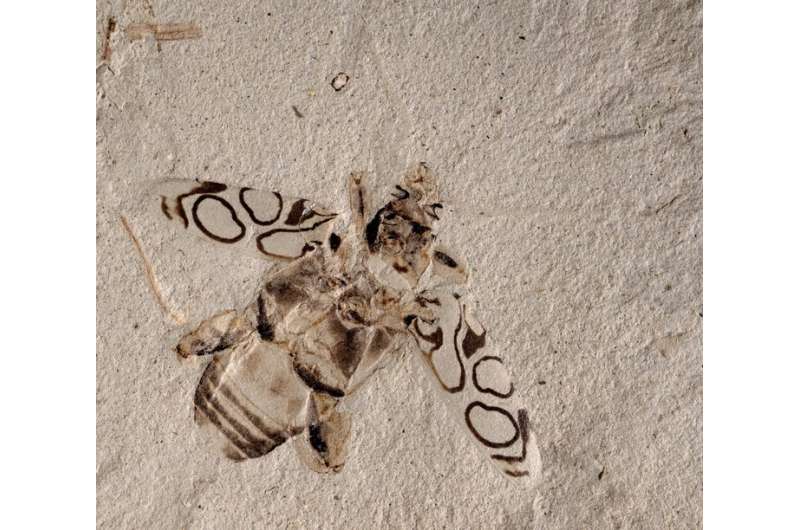Scientists name new frog-legged beetle fossil for Sir David Attenborough

A new frog-legged beetle species, Pulchritudo attenboroughi, or Attenborough's Beauty, was announced today in the scientific journal Papers in Palaeontology. Frank Krell, Denver Museum of Nature & Science Senior Curator of Entomology, and Francesco Vitali, National Museum of Natural History of Luxembourg Invertebrate Zoology Collections Curator, worked together to identify this new species.
The beetle, which has been on display in the Denver Museum of Nature & Science's "Prehistoric Journey" exhibition since it opened in 1995, is from the Green River Formation in Garfield County, Colorado and lived nearly 49 million years ago. Its beautiful patterns on its wing casings caught Krell's eye.
"This is one of the most magnificent beetle fossils ever found," Krell said. "The patterning is preserved in unsurpassed clarity and contrast, making this one of the best-preserved beetle fossils. It is most definitely deserving of its name."
Beetles are sturdy when they are alive, but they do not easily fossilize as a whole beetle. They float on water, and when they sink and reach the sediment, they often fall apart. Usually, only single wing cases are found in the fossil record. Some deposits with a fine-grained sediment and particularly favourable conditions provide us with very well preserved, often almost complete fossils. These deposits are called lagerstätten. The Eocene Green River Formation in northwest Colorado is one of them.
Identifying this specimen was challenging. In the Museum's exhibition display, it was labelled as a longhorn beetle. There were some features that didn't match up with the characteristics of other longhorn beetles, which led Krell to seek out Francesco Vitali, a longhorn beetle expert from the National Museum of Natural History in Luxembourg.
"I was delighted to have the opportunity to work on such a magnificent and unique fossil," Vitali said.
Together, they looked at all the preserved details. In the end, it was the beetle's crooked legs—its curved hind tibiae—that gave away its true identity: a frog-legged leaf beetle.
What's in a Name? A scientific name consists of two components, a genus and a species name, like Homo sapiens. The beetle needed a new genus name, because it did not fit in any existing frog-legged leaf beetle genera. Because of its beauty, Krell and Vicente chose the name Pulchritudo, which is Latin for beauty. Zoologists and botanists often dedicate new species to colleagues who have contributed significantly to science, or to people who are special to them. For Krell, one person immediately came to mind: Sir David Attenborough, English broadcaster and naturalist, who has inspired him, his family and millions of others through his documentaries on the natural world.
"Nobody imparts the grandeur and beauty of nature more impressively than Sir David. This fossil, unique in its preservation and beauty, is an apt specimen to honor such a great man," Krell explained.
See Pulchritudo attenboroughi on Display Pulchritudo attenboroughi, or Attenborough's Beauty, and can be seen in "Prehistoric Journey," in The Cenozoic Era section at the Denver Museum of Nature & Science.
The paper describing the new frog-legged beetle Pulchritudo attenboroughi appears in the Aug. 6 release of the journal Papers in Palaeontology.Tiny beetle named after climate activist Greta Thunberg
More information: Frank‐Thorsten Krell et al, Attenborough's beauty: exceptional pattern preservation in a frog‐legged leaf beetle from the Eocene Green River Formation, Colorado (Coleoptera, Chrysomelidae, Sagrinae), Papers in Palaeontology (2021). DOI: 10.1002/spp2.1398
Provided by Denver Museum of Nature & Science

No comments:
Post a Comment